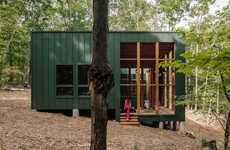The Edge Effect photo series might revolve around a simple concept, but the result is far from that. Instead, the images are captivating in a slightly discombobulating way. Shot at the Joshua Tree National Park in California, the classic desert landscape was broken up by a strategically placed mirror and easel. By reflecting the scene behind the photographer, The Edge Effect photo series captured opposing elements within the environment.
Shot by photographer Daniel Kukla, The Edge Effect photo series is quite magical. The mirror acts like a portal in which the viewer can witness a whole different world. Kukla writes, "Using a single visual plane, this series of images unifies the play of temporal phenomena, contrasts of color and texture, and natural interactions of the environment itself."
Mirrored Landscape Photography
The Edge Effect by Daniel Kukla Captures the Duality of the Desert
Trend Themes
1. Mirrored Landscape Photography - Create captivating and discombobulating images by strategically placing mirrors in natural landscapes.
2. Opposing Elements - Capture contrasting elements within an environment by utilizing reflections in photography.
3. Temporal Phenomena Photography - Unify the play of time, color, and texture in photography by capturing natural interactions of the environment.
Industry Implications
1. Photography - Innovative techniques in capturing landscapes using mirrors can create unique and mesmerizing photographs.
2. Fine Art - Artists can explore the concept of duality and opposing elements in their work by incorporating mirrors into their artistic process.
3. Travel and Tourism - Using mirrored landscape photography can attract visitors by showcasing the unique and captivating aspects of natural environments.






